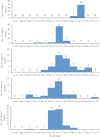Spatial characteristics and the epidemiology of human infections with avian influenza A(H7N9) virus in five waves from 2013 to 2017 in Zhejiang Province, China
- PMID: 28750032
- PMCID: PMC5531501
- DOI: 10.1371/journal.pone.0180763
Spatial characteristics and the epidemiology of human infections with avian influenza A(H7N9) virus in five waves from 2013 to 2017 in Zhejiang Province, China
Abstract
Background: The five-wave epidemic of H7N9 in China emerged in the second half of 2016. This study aimed to compare the epidemiological characteristics among the five waves, estimating the possible infected cases and inferring the extent of the possible epidemic in the areas that have not reported cases before.
Methods: The data for the H7N9 cases from Zhejiang Province between 2013 and 2017 was obtained from the China Information Network System of Disease Prevention and Control. The start date of each wave was 16 March 2013, 1 July 2013, 1 July 2014, 1 July 2015 and 1 July 2016. The F test or Pearson's chi-square test were used to compare the characteristics of the five waves. Global and local autocorrelation analysis was carried out to identify spatial autocorrelations. Ordinary kriging interpolation was analyzed to estimate the number of human infections with H7N9 virus and to infer the extent of infections in the areas with no cases reported before.
Result: There were 45, 94, 45, 34 and 80 cases identified from the first wave to the fifth, respectively. The death rate was significantly different among the five waves of epidemics (χ2 = 10.784, P = 0.029). The age distribution (F = 0.903, P = 0.462), gender (χ2 = 2.674, P = 0.614) and occupation(χ2 = 19.764, P = 0.407) were similar in each period. Most of the cases were males and farmers. A significant trend (χ2 = 70.328, P<0.001) was identified that showed a growing proportion of rural cases. There were 31 high-high clusters and 3 high-low clusters at the county level among the five waves and 12, 8, 2, 9 and 3 clusters in each wave, respectively. The total cases infected with the H7N9 virus were far more than those that have been reported now, and the affected areas continue to expand. The epidemic in the north of Zhejiang Province persisted in all five waves. Since the second wave, the virus spread to the south areas and central areas. There was an obvious decline in the infected cases in the urban areas, and the epidemics mostly occurred in the rural areas after the fourth wave. The epidemic was relatively dispersed since the third wave had fewer than two cases in most of the areas and showed a reinforcing trend again in the fifth wave.
Conclusions: The study revealed that there were few differences in the epidemiologic characteristics among the five waves of the epidemic. However, the areas where the possible epidemic circulated was larger than reported. The epidemic cross-regional expansion continued and mostly occurred in rural areas. Continuous closure of the live poultry market (LPM) is strongly recommended in both rural and urban areas. Illegal and scattered live poultry trading, especially in rural areas, must be forbidden. It is suggested too that a more rigorous management be performed on live poultry trade and wholesale across the area. Health education, surveillance of cases and pathogenicity should also be strengthened.
Conflict of interest statement
Figures







References
-
- Chen Y, Liang W, Yang S, Wu N, Gao H, Sheng J, et al. Human infections with the emerging avian influenza A H7N9 virus from wet market poultry:clinical analysis and characterisation of viral genome. Lancet.2013;381:1916–25. doi: 10.1016/S0140-6736(13)60903-4 . - DOI - PMC - PubMed
-
- Liu D, Shi W, Shi Y, Wang D, Xiao H, Li W, et al. Origin and diversity of novel avian influenza A H7N9 viruses causing human infection: phylogenetic,structural, and coalescent analyses. Lancet. 2013;381:1926–32. http://dx.doi.org/10.1016/S0140-6736(13)60938-1. . - DOI - PubMed
-
- He F, Chen EF, Li FD, Wang XY, Wang XX, Lin JF.Human infection and environmental contamination with Avian Influenza A(H7N9) Virus in Zhejiang Province, China:risk trend across the three waves of infection. BMC Public Health,2015;15:931 doi: 10.1186/s12889-015-2278-0 . - DOI - PMC - PubMed
-
- Li Q, Zhou L, Zhou M, Chen Z, Li F, Wu H, et al. Epidemiology of human infections with avian influenza A(H7N9) virus in China. N Engl J Med. 2014; 370(6):520–32. doi: 10.1056/NEJMoa1304617 . - DOI - PMC - PubMed
-
- Cowling BJ, Jin L, Lau EH, Liao Q, Wu P, Jiang H, et al. Comparative epidemiology of human infections with avian influenza A H7N9 and H5N1 viruses in China: a population-based study of laboratory-confirmed cases. Lancet. 2013; 382(9887):129–37.http://dx.doi.org/10.1016/S0140-6736(13)61171-X. . - DOI - PMC - PubMed
MeSH terms
LinkOut - more resources
Full Text Sources
Other Literature Sources
Medical

